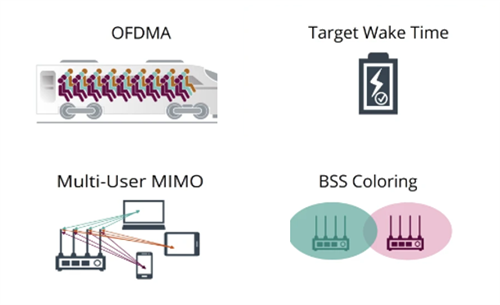SSZTCX4 April 2023 CC3301 , CC3301MOD , CC3351MOD

Wi-Fi® is increasingly available and even expected in many of today’s settings, from a simple at-home blood pressure monitor to a company’s network of devices and entire public utility grids. With Wi-Fi, homeowners can safely and securely control smart ovens, electric vehicle charging stations or sprinkler systems to save time and energy. Building managers can implement remote lighting and climate systems to conserve resources, enhance comfort and reduce expenses. Grid operators can wirelessly detect and resolve problems related to maintenance, energy distribution and security.
Traditionally, Wi-Fi meets performance needs at a manageable cost; it is ubiquitous, interoperable and familiar. For example, Wi-Fi infrastructure is common in many spaces, so product designers don’t have to worry about creating bridges and dongles to connect their products to the internet. Another benefit of Wi-Fi is the broad ecosystem of technology providers that work in the Institute for Electrical and Electronics Engineers (IEEE) 802.11 standards arena – and subsequently with the Wi-Fi Alliance for interoperability testing – to provide an expanding array of features. However, for the increasingly complex, diverse connected network that is the Internet of Things (IoT), not everyone knows the latest Wi-Fi standards, or why they matter.
In the story of Wi-Fi’s evolution, the latest Wi-Fi standard is IEEE 802.11ax, also known as Wi-Fi 6, and it has several little-known capabilities that are optimized for cost-sensitive IoT applications. While Wi-Fi is known for supporting gigabits-per-second, high-throughput options for smartphones and laptops, Wi-Fi 6 now includes features that scale down to tens of megabits per second, resulting in new:
- power-saving protocols,
- range enhancements, and
- spectrum additions
— all of which enable the creation of chip- and module-level products that you can use to easily and affordably add Wi-Fi connectivity to your embedded system designs.
TI’s CC3301 SimpleLinktm companion IC helps implement Wi-Fi 6 in a configuration supporting 20-MHz-wide radio-frequency channels along with integrated Bluetooth Low Energy (BLE). This is an affordable device that you can easily add to a system design with a single antenna, and it supports approximately 86-Mbps physical layer throughput. This is more than sufficient for bulk data-oriented devices such as Internet Protocol (IP) security cameras and printers. It easily scales for sensors and other instruments that may only need a few kilobits-per-second throughput, while supporting the flexibility to reflash quickly (an action that could involve megabytes of data exchange even on a small sensor).
 Figure 1 Features of Wi-Fi6 that the TI
CC301 SimpleLink companion IC supports (source: Wi-Fi Alliance).
Figure 1 Features of Wi-Fi6 that the TI
CC301 SimpleLink companion IC supports (source: Wi-Fi Alliance).TI supports CC3301 and others in the SimpleLink Wi-Fi 6 family with software offerings that also scale well for IoT computing resources, ranging from microprocessor (MPU)-based products that run embedded Linux® to microcontroller (MCU)-based products that run FreeRTOS. The family includes offerings with a 2.4-GHz radio, as well as dual-band 2.4- and 5-GHz and tri-band 2.4-, 5- and 6-GHz products. Additionally, some products include BLE, which you can use for Wi-Fi provisioning or as an embedded gateway.
While Wi-Fi 6 is known for its high-throughput capabilities, there are several features that also bring benefits to IoT applications in the areas of new spectrum, advanced security, power reduction and latency management. The table below (Figure 2) summarizes of some of these features:
| Wi-Fi 6 feature | Benefit for IoT applications |
|---|---|
| Wi-Fi protected access 3 security | This provides the latest security protocols for consumer and enterprise networks. It is available as an option for earlier generations of Wi-Fi, but is a prerequisite for Wi-Fi 6. |
| Access to the newly allocated 6-GHz spectrum | Up to 1 GHz of new unlicensed spectrum is being made available worldwide in the 6-GHz band for use by Wi-Fi 6. This will reduce network congestion and in turn improve throughput, while reducing latency and power consumption. (Earlier generations of Wi-Fi will not operate in the 6-GHz band.) |
| Target wake-time protocol | Enables flexibility for a product to negotiate wake and sleep timing with a Wi-Fi access point, which may help extend battery life in power-sensitive applications. |
| Trigger frames sent from an access point | Wi-Fi 6 allows the access point to send trigger frames to specific products on the network that trigger communication. This is an enhancement to the random transmission and collision technique used on legacy networks. Trigger frames reduce collisions on the network and improve quality of service. |
| Orthogonal frequency-division multiple access | This is a physical layer scheme that allows the splitting of a single 20-MHz channel between as many as nine IoT devices so that they can all transmit and receive at the same time, allowing for reduced network latency, fewer collisions and better spectral efficiency. |
| Multiuser multiple input, multiple output | A technique that allows a single access point to communicate with multiple IoT products at the same time, thus increasing network capacity and reducing latency. |
| Basic service set coloring | A technique that allows an IoT product to transmit if it can detect a signal from an access point to which it is not connected (earlier Wi-Fi generations do not allow this). This increases throughput and reduces latency, especially in dense network deployments. |
With the SimpleLink Wi-Fi 6 family of devices, TI brings the benefits of Wi-Fi 6 to IoT applications that you can evaluate today using TI processor software development kits and TI MCU LaunchPadtm development kits.
Additional Resources:
- See the data sheet for CC330X devices
- Get started with the BP-CC301 EVM
- Get started with the AM335 or AM62 EVM for Linux evaluation
- Watch the Wi-Fi 6 Training Video Series
- Learn about all TI Wi-Fi products